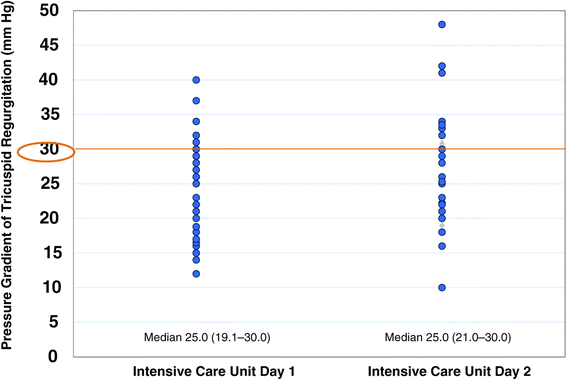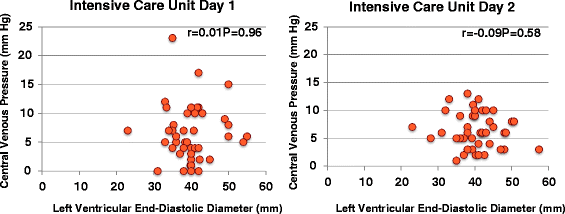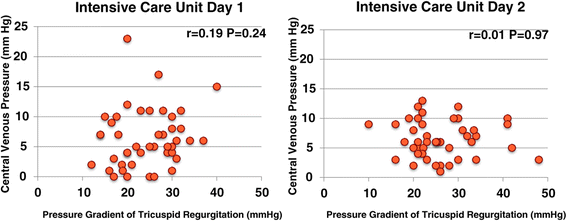Reliability of central venous pressure to assess left ventricular preload for fluid resuscitation in patients with septic shock
- PMID: 25705416
- PMCID: PMC4336121
- DOI: 10.1186/s40560-014-0058-z
Reliability of central venous pressure to assess left ventricular preload for fluid resuscitation in patients with septic shock
Abstract
Background: Initial fluid resuscitation is an important hemodynamic therapy in patients with septic shock. The Surviving Sepsis Campaign Guidelines recommend fluid resuscitation with volume loading according to central venous pressure (CVP). However, patients with septic shock often develop a transient decrease in cardiac function; thus, it may be inappropriate to use CVP as a reliable marker for fluid management.
Methods: We evaluated 40 adult patients with septic shock secondary to intra-abdominal infection who received active treatment and were monitored using transthoracic echocardiography (TTE) and CVP for 2 days after admission to our intensive care unit (ICU). We measured left ventricular end-diastolic diameter (LVEDD), left atrial diameter (LAD), and the pressure gradient of tricuspid regurgitation (TR∆P). The shock status was treated with volume loading and inotrope/vasopressor administration according to the TTE findings. We assessed left ventricular fractional shortening (LVFS) as an index of left ventricular contractility and TR∆P as an index of right ventricular afterload and then examined the correlation between CVP and LVEDD/LAD/TR∆P.
Results: LVFS decreased to ≤30% in 42.5% and 27.5% of patients with septic shock, and severe left ventricular dysfunction with LVFS ≤20% developed in 12.5% and 15.0% of patients on the first and second ICU days, respectively, despite the use of inotropes/vasopressors. Mild pulmonary hypertension as indicated by TR∆P ≥30 mmHg was present in 27.5% and 30.0% of patients on their first and second ICU days, respectively. There was no significant correlation between CVP and LVEDD/LAD/TR∆P. The hospital mortality rate in this study was 10.0%, although the predicted mortality based on the Acute Physiology and Chronic Health Evaluation II score was 58.7%.
Conclusions: Our results suggest that CVP is not a reliable marker of left ventricular preload for fluid management during the initial phase of septic shock. Assessment of left ventricular preload, right ventricular overload, and left ventricular contractility using TTE seems to be more informative than the measurement of CVP for fluid resuscitation since some patients developed left ventricular dysfunction and/or right ventricular overload.
Keywords: Central venous pressure; Echocardiography; Septic shock.
Figures






References
-
- Dellinger RP, Levy MM, Rhodes A, Annane D, Gerlach H, Opal SM, Sevransky JE, Sprung CL, Douglas IS, Jaeschke R, Osborn TM, Nunnally ME, Townsend SR, Reinhart K, Kleinpell RM, Angus DC, Deutschman CS, Machado FR, Rubenfeld GD, Webb SA, Beale RJ, Vincent JL, Moreno R, Surviving Sepsis Campaign Guidelines Committee including the Pediatric Subgroup Surviving sepsis campaign: international guidelines for management of severe sepsis and septic shock: 2012. Crit Care Med. 2013;41:580–637. doi: 10.1097/CCM.0b013e31827e83af. - DOI - PubMed
-
- Yanai H. Statcel-The Useful add-in Software Forms on Excel. 3. Tokyo: OMS; 2011.
LinkOut - more resources
Full Text Sources
Other Literature Sources

